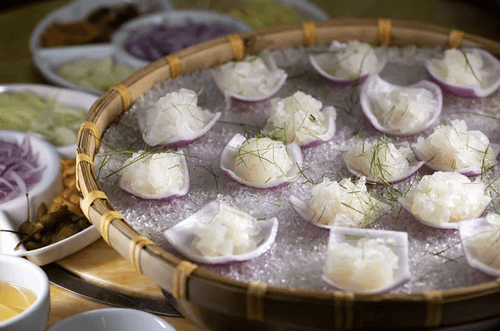
The Art of "One Fish, Many Ways" – Shunde’s Culinary Masterpieces
Introduction: Welcome to Shunde—a UNESCO City of Gastronomy and the revered birthplace of Cantonese cuisine. Shunde is famous globally for its delicate, subtle, and supremely fresh flavors. At the heart of this culinary tradition is the mastery of freshwater fish, a philosophy known locally as "One Fish, Many Ways." In this piece, we explore the signature "hard dishes" that showcase the extraordinary skill of Shunde’s master chefs.
Shunde Raw Fish Salad (顺德鱼生): The Oriental "Sashimi" with a Thousand-Year Heritage
History and Heritage: Yusheng (Raw Fish) traces its roots back to ancient Chinese food culture, reaching its peak during the Song Dynasty. It was refined and preserved in Shunde’s Sangji Yutang (Mulberry Dykes and Fish Ponds) water villages. This dish is the ultimate expression of confidence in the local, pristine aquaculture.
Preparation and Craftsmanship: Selecting the freshest fish from healthy, clear waters is the first crucial step. The soul of the dish, however, lies in the chef’s exquisite knife skills (dao gong). The fish is sliced paper-thin and translucent, a technique that enhances its crispness and sweetness. Diners then mix (or "toss," known as lao qi) the slices with over a dozen condiments like ginger, spring onions, peanuts, and lemon leaves—a ritual symbolizing good fortune.
Taste Profile: The fish is served chilled, offering a wonderfully crisp, clean, and naturally sweet flavor. The condiments add layers of nutty, aromatic, and savory notes, creating a complex yet refreshing experience unmatched by other raw-fish dishes.
Hometown Stuffed Dace (家乡酿鲮鱼): The Ancient Wisdom of "Whole Fish Restoration"
History and Heritage: This is a classic Shunde specialty reflecting the water village families’ ethos of thrift and resourcefulness. Since the Dace fish (ling yu) has many small bones, Shunde chefs invented a technique to "debone" it while keeping the skin intact, making it enjoyable for all.
Preparation and Craftsmanship: This dish is a true test of patience and manual dexterity. The chef must delicately remove all the flesh and bones while preserving the fish’s skin. The flesh is then deboned, minced, mixed with mushrooms and water chestnuts, and re-stuffed into the original skin before being pan-fried or steamed.
Taste Profile: The exterior skin is pan-fried to a slight crisp, while the filling inside is savory, tender, and springy (teng) due to the water chestnuts. It beautifully balances the pure fish flavor with aromatic fillers.
Junan Steamed Whole Pig (均安蒸猪): The Non-Material Cultural Heritage of Village Feasts
History and Heritage: Originating in the Jun'an township during the Qing Dynasty (around 1862–1874), the Steamed Whole Pig was traditionally the centerpiece for ancestral ceremonies and grand banquets. It has been recognized as a city-level Intangible Cultural Heritage.
Preparation and Craftsmanship: A whole suckling pig (around 50-100 kg) is marinated with wine, salt, and various spices, then placed in a custom-made fir-wood steamer box and steam-cooked. Crucially, immediately after cooking, the skin is repeatedly punctured to drain excess grease before a final roasting. This process ensures the skin is crisp and the meat is tender, achieving the unique flavor of "fat but not greasy."
Taste Profile: The skin is satisfyingly crisp and golden. The meat is exceptionally tender, juicy, and infused with the subtle aromas of the marinade and the fir wood, a wholesome and powerful dish.
Shunde Fish Bone Soup (顺德拆鱼羹): The Delicate Touch of the "Ma Jie" Cooks
History and Heritage: This soup is emblematic of the "Ma Jie Cuisine," a style of cooking developed by Shunde zishu nü (self-combed women, unmarried domestic workers) who brought their meticulous culinary skills to wealthy households. It perfectly embodies the Shunde philosophy of refinement and utilizing every part of the ingredient.
Preparation and Craftsmanship: The fish bones are first boiled into a milky-white broth. The steamed fish flesh is then patiently and manually shredded into fine, pure strands, ensuring zero bones. The strands are combined with egg, wood ear fungus, and loofah gourd and thickened into a savory soup. The meticulous hand-shredding is the key craft.
Taste Profile: The consistency is warm, smooth, and silken. The flavor is profoundly fresh and sweet, making it a highly nourishing and comforting dish, often favored by the elderly and children.
Rice-less Congee Hot Pot (毋米粥火锅): The Healthy Revolution of Shunde Hot Pot
History and Heritage: While a modern invention, this dish is rooted in Shunde's dedication to preserving the purity and original flavor of ingredients. It transforms the often-heavy hot pot experience into a light, healthy feast.
Preparation and Craftsmanship: The signature broth is made by boiling rice for several hours until the grains have completely disintegrated, leaving only a creamy white emulsion of rice starch and oil—hence "rice-less." This broth acts as a cooking medium, not a seasoning, maximizing the freshness of the meats and seafood dipped in it.
Taste Profile: The congee base is mild and velvety. As ingredients are swirled, the broth absorbs their flavors and, more importantly, coats them in a subtle layer of rice starch, making the food extraordinarily tender, sweet, and pure.
Sauna Fish (桑拿鱼): The Purity of Steam
History and Heritage: Sauna Fish is a modern reflection of the Shunde principle of freshness and lightness. It utilizes contemporary tools to execute the ancient Chinese technique of steaming in the cleanest way possible.
Preparation and Craftsmanship: Thinly sliced fish is arranged on a layer of lotus or mulberry leaves on a specialized steamer. Crucially, no water is added to the pot; the fish is cooked solely by high-temperature steam. The heat must be controlled precisely to cook the fish just enough, ensuring the most tender texture.
Taste Profile: The fish is exquisitely smooth and delicate, absorbing a faint, pleasant herbal scent from the leaves. It is the epitome of clean eating, focusing entirely on the quality of the aquatic protein.
Four-Cup Chicken (四杯鸡): The Balanced Sweet and Savory Classic
History and Heritage: A traditional home-style dish, Si Bei Ji (Four-Cup Chicken) is related to the famous Taiwanese "Three-Cup Chicken" but with a distinct Cantonese flavor profile, often focusing on a sweet and rich glaze.
Preparation and Craftsmanship: Chicken is cooked with four main liquids (typically soy sauce, sugar, wine, and oil/broth) and slowly reduced in a clay pot. The craft lies in the constant basting and reduction, which creates a rich, sticky glaze and allows the flavor to deeply penetrate the chicken skin.
Taste Profile: The chicken is tender with glistening, flavorful skin. The sauce is intensely aromatic, balancing sweetness and savoriness with a distinct hint of Chinese wine, making it a fantastic pairing for white rice.


